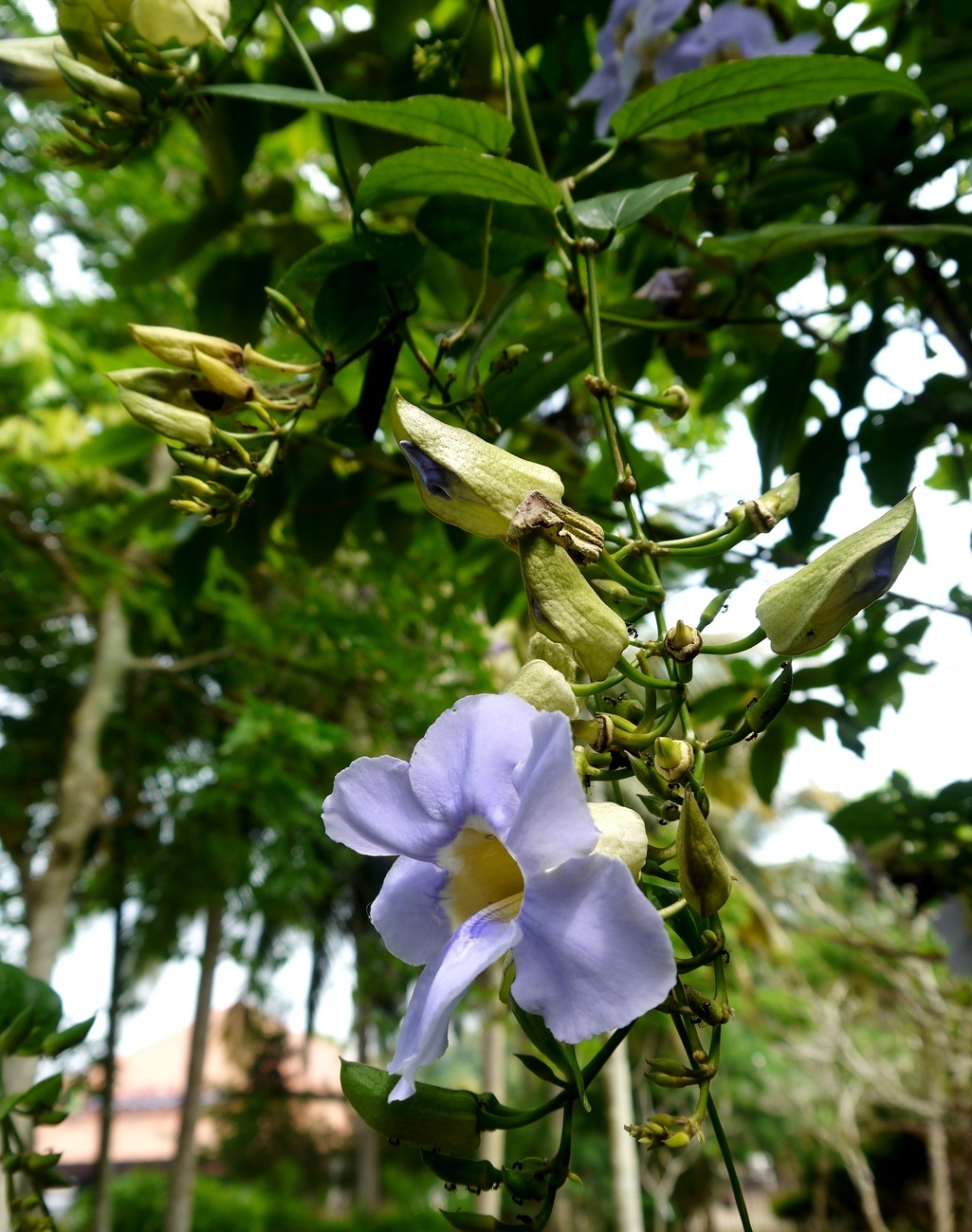Fragrant clock vine
(Thunbergia fragrans fragrans)

Description
Thunbergia fragrans fragrans, commonly known as the Fragrant Clock Vine, is a captivating flowering vine that belongs to the family Acanthaceae. Native to India and Sri Lanka, this tropical climber is celebrated for its exquisite blooms and delightful fragrance. With its attractive appearance and alluring scent, Thunbergia fragrans fragrans has become a popular choice among gardeners and plant enthusiasts around the world. Taxonomy and Nomenclature Thunbergia fragrans fragrans is a subspecies within the Thunbergia fragrans species. The genus Thunbergia is named in honor of Carl Peter Thunberg, a Swedish botanist and student of Carl Linnaeus. The specific epithet "fragrans" is derived from the Latin word for "fragrant," which perfectly describes the enchanting aroma emitted by the flowers. Description Thunbergia fragrans fragrans is a woody climbing vine with twining stems that can reach impressive heights of up to 6 meters (20 feet) or more. The leaves are simple, opposite, and ovate to elliptical in shape, measuring around 5 to 10 centimeters (2 to 4 inches) in length. The foliage possesses a vibrant green color, providing an excellent backdrop to showcase the striking flowers. The flowers of Thunbergia fragrans fragrans are the true highlight of this species. They are large, trumpet-shaped, and typically measure around 5 centimeters (2 inches) in diameter. Each flower has five petals that spread out to form a beautiful symmetrical display. The color palette ranges from pale cream to white, with delicate yellow or purple markings at the throat of the flower. What truly sets Thunbergia fragrans fragrans apart is its captivating fragrance, reminiscent of jasmine or honeysuckle, which permeates the surrounding area. Habitat and Range Thunbergia fragrans fragrans is native to India and Sri Lanka, where it is commonly found in its natural habitat. In these regions, it thrives in warm tropical and subtropical climates. The vine is well-adapted to the local conditions and can be found growing in a variety of habitats, including forests, woodlands, scrublands, and along the edges of water bodies. Outside of its native range, Thunbergia fragrans fragrans has been cultivated and naturalized in various tropical and subtropical regions around the world. It is particularly popular in regions with similar climatic conditions, such as parts of Southeast Asia, Africa, the Caribbean, and some parts of Central and South America. When grown in regions with colder climates, Thunbergia fragrans fragrans is often cultivated as a container plant or grown in greenhouses, allowing enthusiasts to enjoy its beauty and fragrance in areas where it may not survive outdoors year-round. Overall, the habitat and range of Thunbergia fragrans fragrans are primarily tropical and subtropical regions, both within its native range in India and Sri Lanka and in regions with similar climates where it has been introduced. Cultivation Thunbergia fragrans fragrans thrives in warm tropical and subtropical climates, making it well-suited for regions with mild winters and long, hot summers. It prefers a sunny or partially shaded location and requires support to climb upon, such as trellises, fences, or arbors. This vine is known for its rapid growth and can quickly cover large areas if not pruned regularly. In terms of soil preferences, Thunbergia fragrans fragrans is not overly demanding. It will thrive in a well-draining soil enriched with organic matter. Adequate moisture is essential for healthy growth, so regular watering is necessary, particularly during dry periods. Applying a balanced, slow-release fertilizer during the growing season can help promote vigorous growth and abundant blooms. Propagation The Fragrant Clock Vine can be propagated through various methods, including seeds, stem cuttings, or layering. Seeds should be sown in a well-draining potting mix and kept consistently moist until germination, which typically takes several weeks. Stem cuttings, taken from the tips of the plant, can be rooted in a moist rooting medium, such as a mixture of perlite and peat moss. Layering involves bending a low-growing stem into the soil and allowing it to develop roots before severing it from the parent plant. Uses and Benefits Thunbergia fragrans fragrans has several practical and aesthetic uses. In tropical regions, it is commonly grown as an ornamental vine, adding charm and elegance to gardens, fences, and pergolas. Its enchanting fragrance makes it a popular choice for scenting outdoor living areas, patios, and courtyards. The flowers are also attractive to pollinators, such as bees and butterflies, contributing to the biodiversity of the surrounding ecosystem. In addition to its aesthetic value, Thunbergia fragrans fragrans has some traditional medicinal uses. In certain traditional medicine systems, such as Ayurveda, parts of the plant, including the leaves and flowers, are believed to possess therapeutic properties. They are used in the treatment of various ailments, including fevers, respiratory disorders, and skin conditions. However, it is important to note that the efficacy and safety of these traditional uses have not been extensively studied, and it is always advisable to consult with a healthcare professional before using any plant-based remedies. Furthermore, Thunbergia fragrans fragrans can also be grown as a potted plant or trained as a hanging basket specimen, allowing it to be enjoyed indoors or in areas with colder climates. Its cascading vines and fragrant blooms can add a touch of tropical ambiance to any living space. Cultural Significance Thunbergia fragrans fragrans has gained cultural significance in its native regions. In India, the plant is commonly known as "Sunderbai," and its flowers are used in religious ceremonies and garland-making. The fragrance of the flowers is believed to have a calming and soothing effect, making it a popular choice for decorations during festive occasions and weddings. Conclusion Thunbergia fragrans fragrans, the Fragrant Clock Vine, is a remarkable climbing vine celebrated for its striking flowers and captivating fragrance. Its rapid growth, ease of cultivation, and aesthetic appeal make it a popular choice among gardeners and plant enthusiasts worldwide. Whether adorning garden trellises or gracing indoor spaces, this enchanting vine adds beauty, fragrance, and a touch of the tropics wherever it grows.
Taxonomic tree:







